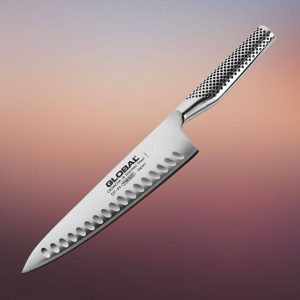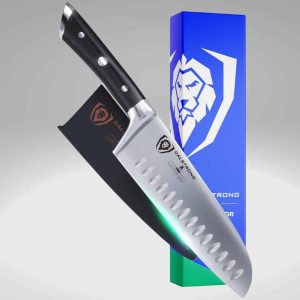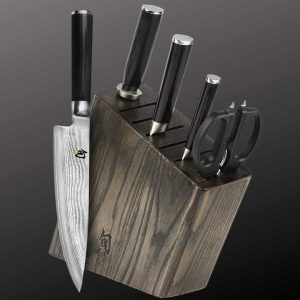Welcome to your journey into the world of culinary tools, a world I have inhabited for the better part of three decades. As a seasoned chef with 27 years of experience under my belt, I’ve learned a thing or two about the tools that can elevate your cooking to the next level. The chef knife, in particular, is more than a mere tool – it’s a culinary companion that, if chosen and cared for correctly, can turn even the simplest meal into a work of art.
Start Simple and Grow Your Knife Collection with Time
You may be wondering where to start on this journey, especially when faced with the dazzling array of options available. You’ve probably seen those imposing blocks filled with every knife imaginable from those big German manufacturers. But trust me, you don’t need all of them to get started. The three knives that have served me most faithfully, out of all the varieties I’ve had the privilege to handle, are the Chef’s Knife, a utility knife, and a bread knife.
Here’s a little secret: a good Chef’s Knife, well-balanced and suited to your hand, can accomplish most tasks in the kitchen with grace and precision. As you delve further into your culinary journey, you’ll find that this versatile tool will quickly become your right hand in the kitchen, whether you’re mincing delicate herbs or breaking down a hefty cut of meat.
As you explore further into the world of knives, you’ll notice that the materials used in the blade, the weight and balance of the knife, and its longevity are essential factors to consider. These considerations will help you find a knife that is not only functional but a joy to use.
This may all sound overwhelming at first, but worry not. As your culinary guide, I’m here to break it all down for you. So, strap on your apron, sharpen your curiosity, and let’s embark on this cutting-edge culinary journey together. This is the start of your personalized journey to finding the best Chef’s knives tailored to your culinary needs.
The Chef Knife
The chef knife, or as the French aptly named it, “Le Couteau de Chef”, is more than just a tool; it’s the workhorse of the kitchen, a trusted partner in your culinary adventure. In my experience, it’s the most indispensable item in a chef’s arsenal, doing the heavy lifting in most meal preparations.
When it comes to the anatomy of a Chef’s Knife, it all comes down to three main components: the blade, the handle, and the bolster. The blade does the cutting. Depending on the design, a good chef’s knife may have a bit of a curve to the blade’s edge. This curve can enhance the natural rocking motion of chopping, making it especially handy when mincing garlic, dicing onions, or chopping herbs.
Next, we have the handle, which needs to feel comfortable and secure in your grip. Remember, you’ll be wielding this kitchen companion quite frequently, so the right fit is paramount.
Finally, we come to the bolster, the thick junction between the handle and the blade. This is an important factor as it adds balance and stability, providing you with better control over your cuts.
Now, selecting the perfect chef’s knife may seem like a daunting task, especially with so many options on the market. However, there are a few factors to consider to help make your decision easier. One key aspect to consider is the size of the knife. An 8″ Chef’s Knife is typically a great starting point for home cooks. It’s versatile, manageable, and can handle most kitchen tasks with ease.
Another factor to think about is your hand size and cutting technique. If you have smaller hands or are new to cooking, you might find a lighter knife with a slim handle more comfortable. On the other hand, if you have larger hands or prefer a “rock chop” style of cutting, a knife with a more substantial handle might suit you better.
Remember, the ultimate goal is to find a chef’s knife that feels like an extension of your hand – that’s when the real magic happens in the kitchen! The chef’s knife you choose will likely become your culinary confidant, ready to take on any challenge the kitchen throws at you.
Best German Chef Knife
If you’re in the market for a high-quality, reasonably priced German knife, then the Wusthof Gourmet 2 Piece Chef’s Knife Set is my top recommendation. This set offers fantastic value, combining the versatility of an 8″ Chef’s Knife with the precision of a 4″ Utility Knife. Here’s why it stands out:
- Quality and Value: This knife set is part of Wusthof’s Gourmet Series, known for their superior quality and value. They are precisely laser-cut stamped knives that are known for their sharpness and durability.
- Durability: These knives feature high carbon stainless steel blades, resistant to corrosion and dulling. They are also equipped with synthetic polypropylene handles, designed to resist fading, discoloration, heat, and impact. This ensures that the knives will maintain their look and performance even with heavy usage.
- Sharpness: The blades are razor-sharp, precisely cut with the latest technology for easy maintenance. The blades are laser tested for uniform cutting and long-lasting sharp edge.
- Authenticity: Wusthof, a family-owned brand for seven generations, has its roots in Solingen, Germany – known as “the cutlery capital of the world”. The Solingen name stamped on Wusthof knives is a guarantee of quality and tradition.
- Set Composition: This set includes an 8″ Chef’s Knife for versatile chopping and mincing tasks, and a 4″ Utility Knife, perfect for more delicate tasks such as peeling and slicing.
Remember, this recommendation is based on my years of experience and love for high-quality German knives. The Wusthof Gourmet 2 Piece Chef’s Knife Set could be a great addition to your kitchen, offering a balance of quality, durability, and value.
Best Japanese Chef Knife
If your preference leans towards the precision and finesse of Japanese craftsmanship, then the Global Model X Chef’s Knife could be the perfect match for you. Made in Japan, this 8″ Hollow Edge knife offers a delicate balance of style, performance, and ergonomics. Let’s explore why this knife has made the cut:
- Quality Material: This knife is made from Cromova 18, an exclusive blend of Chromium, Molybdenum, and Vanadium. This blend of metals results in a strong, durable blade that maintains its sharp edge.
- Optimal Balance: The hollow handle of the knife is filled with sand to achieve the perfect weight balance. This precise weighting provides optimal control when you’re cutting, enhancing your culinary skills.
- Sharper and Long-lasting Edge: The blade is ice tempered and hardened to Rockwell 56-58 degrees. This hardness level ensures that the razor-sharp edge lasts longer than blades made from other types of steel.
- Comfortable and Hygienic Handle: The knife features a stainless steel handle with a signature dimple pattern. This design not only gives the knife a unique look but also offers a comfortable, slip-resistant grip. It allows for a pinch grip, offering incredible control for precise chopping.
- Japanese Craftsmanship: This knife carries the proud tradition of Japanese knife-making, known for its lightweight design and thinner blades compared to Western-style German knives.
In conclusion, the Global Model X Chef’s Knife is an exquisite demonstration of Japanese knife craftsmanship. It is a brilliant choice for anyone looking to explore the world of Japanese knives, providing durability, balance, and superior cutting performance. Plus, it comes with a lifetime warranty, a testament to its quality and durability.
Best Chef Knife for Vegetables
If you often find yourself chopping, dicing, or mincing vegetables, the DALSTRONG Santoku Knife from the Gladiator Series might be the perfect tool for your culinary adventures. This 7″ knife is crafted with care from high-carbon German steel, making it a solid, durable, and incredibly sharp kitchen companion. Here’s why this knife is an exceptional choice:
- Craftsmanship and Material: With outstanding craftsmanship and cutting-edge technology, the DALSTRONG Santoku Knife boasts high-carbon German steel. It is impressively razor-sharp, and the blade is hand-polished at 16-18 degrees per side for superior cutting performance.
- Innovative Design: The knife features oval-shaped hollow divots on the blade. These help minimize the suction of food stuck to the blade, allowing you to slice faster and cleaner.
- Comfortable Handle: The black G10 Garolite handle ensures comfort and maneuverability during usage. It’s triple-riveted, laminated, and polished, making it sanitary and perfect for busy kitchens.
- Hardness and Flexibility: This knife is engineered to perfection with a 56+ Rockwell hardness and is hand-polished to a satin finish. It’s carefully tapered for improved hardness and flexibility while also providing useful knuckle clearance.
- Satisfaction Guarantee: DALSTRONG stands by the quality of its products. The knife comes with a 100% satisfaction or money-back guarantee, allowing you to try it risk-free.
With the DALSTRONG Santoku Knife, you get more than just a knife. You get a blend of design, technology, and performance, tailor-made for all your vegetable-cutting tasks. It’s not just a knife; it’s an investment in your culinary journey.
Buying for a Friend or Family Member?
Buying a Chef’s Knife as a gift can be a thoughtful gesture, whether it’s for a loved one who’s just starting on their culinary journey or an experienced chef looking to upgrade their game. Here are some pointers to keep in mind when selecting a knife as a gift:
- Consider the Recipient’s Cooking Habits: The ideal chef knife can depend heavily on what the recipient usually cooks. If they frequently deal with meat, a heavy-duty German knife may be the way to go. However, if they prefer dealing with fish or vegetables, a lighter, thinner Japanese knife might be more suitable.
- Understand their Experience Level: A beginner might appreciate a versatile, easy-to-handle knife like the Mercer Culinary, 8 Inch Chef’s Knife with Leaf Pattern Blade. On the other hand, the Shun Classic 8 Inch Hollow Ground Chef’s Knife might be better for someone who has been cooking for a while and is ready to elevate their game.
- Assess their Preferences: Some people appreciate the classic design of German knives, while others are more drawn to the elegance and precision of Japanese knives. Consider the design, handle comfort, and blade type that they may prefer.
Remember, the best Chef’s Knife is not only about its practicality but also about the story it tells. Whether it’s a gift for a holiday, birthday, or just because, giving a chef’s knife can be a symbol of respect for the recipient’s passion for cooking. Your gift could be the tool they use to prepare countless meals, turning each dish into a work of art. That’s the power a good Chef’s Knife holds, and why it’s the most important knife one can own.
Key Takeaways
As we’ve explored the world of chef’s knives, there are some fundamental points you should keep in mind when selecting your ideal kitchen companion:
- A Chef’s Knife is the most crucial tool in your kitchen; choose wisely based on your cooking habits and personal preferences.
- For a sturdy, reliable choice, consider German knives like the Wusthof Gourmet 2 Piece Chefs Knife Set, known for their excellent balance and durability.
- If you’re looking for a lighter and precise option, Japanese knives like the Global Model X Chef’s Knife offer unparalleled sharpness and control.
- When chopping vegetables, a Santoku Knife, such as the DALSTRONG Santoku Knife from the Gladiator Series, can significantly enhance your culinary experience.
- If you’re gifting a knife, take into consideration the recipient’s cooking habits, experience level, and personal preferences. Your choice of knife could become a cherished tool in their cooking journey.
Frequently Asked Questions
- How often should I sharpen my Chef’s Knife?
- Sharpening frequency depends on how much you use your knife and the type of material it’s made from. As a general rule, a chef’s knife should be sharpened every few months under normal household use. However, if you notice that your knife is not cutting as smoothly as it once was, it might be time for a sharpening session.
- What is the best way to store my Chef’s Knife?
- Storing your chef’s knife properly can extend its lifespan and maintain its sharpness. Avoid tossing it into a drawer with other utensils as it can cause the blade to dull faster. Instead, use a knife block, a magnetic knife strip, or a sheath to keep your knife safe and sound.
- Can I put my Chef’s Knife in the dishwasher?
- While some knives are marketed as dishwasher safe, it’s generally recommended to hand wash your chef’s knife. The heat and detergent in a dishwasher can damage the blade and handle over time. Hand washing with mild soap and drying immediately is the best way to keep your knife in top condition.
- How do I safely use a Chef’s Knife?
- Proper handling of a chef’s knife involves keeping your fingers away from the blade and using a stable cutting surface. Always cut away from your body and keep the tip of the knife on the cutting board as much as possible. Remember, safety comes first in the kitchen!
- What makes a good Chef’s Knife for a beginner?
- For beginners, it’s best to choose a chef’s knife that feels comfortable in your hand and isn’t too heavy. The Mercer Culinary 8 Inch Chef’s Knife, for instance, is a solid, entry-level knife. As your skills grow, you might prefer a knife with more specialized features.





